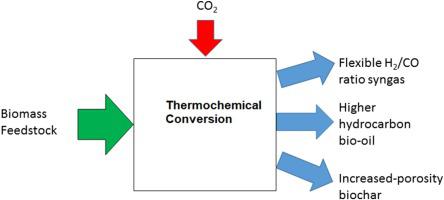Journal of CO2 Utilization ( IF 7.2 ) Pub Date : 2020-06-23 , DOI: 10.1016/j.jcou.2020.101217 Ashak Mahmud Parvez , Muhammad T. Afzal , Thayne George Victor Hebb , Max Schmid

|
CO2 is the primary greenhouse gas emitted through human activities. CO2 emissions from burning fossil fuels increased by approximately 2.7 percent in 2018, after global emissions of 35.8 Gt in 2017. Thus, finding energy and cost-effective methods to use the CO2 generated from industries for productive purposes is crucial, abating CO2 emissions while producing economic benefits. This paper aims to comprehensively review the effects of CO2 on syngas, biochar and bio-oil from gasification and pyrolysis processes. It was found that the utilization of CO2 during gasification and pyrolysis provides both control over syngas H2/CO ratio and biochar with enhanced properties for high value applications. Furthermore, it was determined that co-gasification under CO2 atmosphere can enhance synergistic effects. Results also showed that the presence of CO2 can increase the hydrocarbon concentration of bio-oil due to the different reactions that can occur between biomass and CO2 compared to biomass and N2. The use of CO2 as a feedstock also reduces the net CO2 emissions and therefore provides environmental benefits. However, the utilization of CO2 during biomass gasification and pyrolysis currently has some limitations, including the endothermic nature of gasification reactions, resulting in large energy and compressed CO2 inputs, which can be expensive. It is recommended that comprehensive studies to address the current limitations of the utilization of CO2 in biomass gasification and pyrolysis processes be conducted. Promoting the use of CO2 is integral to global CO2 emission reduction, aiding in efforts to achieve CO2 emission regulations outlined by the Paris Agreement (PA).
中文翻译:

利用CO 2进行生物质的热化学转化以提高产品性能:综述
CO 2是人类活动所排放的主要温室气体。在2017年全球排放35.8 Gt之后,燃烧化石燃料产生的CO 2排放量在2018年增加了约2.7%。因此,寻找能源和具有成本效益的方法来利用工业产生的CO 2进行生产是至关重要的,这要减少CO 2排放,同时产生经济效益。本文旨在全面回顾CO 2对气化和热解过程中合成气,生物炭和生物油的影响。发现在气化和热解过程中利用CO 2可以同时控制合成气H 2。/ CO比和生物炭具有增强的特性,可用于高价值应用。此外,已经确定在CO 2气氛下的共气化可以增强协同作用。结果还表明,CO 2的存在可以增加生物油的碳氢化合物浓度,这是由于与生物质和N 2相比,生物质和CO 2之间可能发生不同的反应。使用CO 2作为原料还减少了CO 2净排放量,因此提供了环境效益。但是,CO 2的利用在生物质气化和热解过程中,目前存在一些局限性,包括气化反应的吸热性质,导致大量能量和压缩的CO 2输入,这可能是昂贵的。建议进行综合研究以解决目前在生物质气化和热解过程中利用CO 2的局限性。促进CO 2的使用是全球减少CO 2排放不可或缺的一部分,有助于实现《巴黎协定》(PA)概述的CO 2排放法规。











































 京公网安备 11010802027423号
京公网安备 11010802027423号